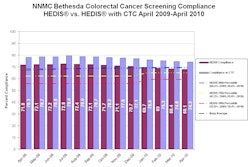Seniors who undergo conventional colonoscopy suffer far higher rates of cardiac events and colonic perforations than patients who don't get the procedure, concluded a study to be presented on Wednesday at the 2010 American College of Gastroenterology (ACG) annual meeting in San Antonio.
Over several years the retrospective analysis followed the Medicare records of more than 350,000 patients 65 and older, half of whom underwent conventional colonoscopy and half of whom did not. Cardiac events were nearly three times as likely and complications more than twice as likely in the colonoscopy group.
Commenting on the results, a leading gastroenterologist not associated with the study cautioned that the higher event rates in the colonoscopy group were in line with previous research, and that existing comorbidities among the elderly may have predisposed them to a higher event rate whether or not they had colonoscopy.
But a virtual colonoscopy expert countered that the high rate of events confirms the need for a less invasive, less risky colon exam in elderly patients.
Medicare sample
In their retrospective analysis, Fuad Azrak, MD, and colleagues from Emory University in Atlanta examined the Medicare records of a random sample of 5% of individuals who underwent outpatient colonoscopy between 1992 and 2007, comparing a total of 174,352 persons who underwent outpatient colonoscopy to a second matched, population-based randomized cohort of 174,352 controls who were not screened. (Azrak was attending the ACG meeting at press time and was not immediately available for comment.)
The colonoscopy cohort was matched by demographics to the group of Medicare beneficiaries who did not undergo colonoscopy, and to a comorbidity score using data from the Surveillance, Epidemiology, and End Results (SEER) cancer registry. Patients were excluded if diagnosed with any cancer or inflammatory bowel disease, or if they had an incomplete colonoscopy.
Aiming to tie the colonoscopy procedure to a subsequent need for urgent care, the researchers then examined Medicare claims data to identify "all individuals who, within 30 days after colonoscopy, visited emergency departments or were hospitalized with the possible gastrointestinal and cardiovascular complications such as bleeding, perforation, angina/myocardial infarction [MI], arrhythmias, and death," Azrak and colleagues wrote in an accompanying abstract.
They studied complication rates in three time periods based on Medicare coverage of screening colonoscopy (no coverage: 1992-1997; limited coverage: 1998-June 2001; and full coverage: July 2001-2007). Chi-squared tests were used to calculate statistical significance.
The results showed a small but significantly higher rate of perforation/bleeding, and more cardiac events, in the population that underwent endoscopy.
Complication rates, colonoscopy vs. noncolonoscopy
|
Both perforation/bleeding rates and reported angina/myocardial infarction rates were significantly higher in patients who underwent optical colonoscopy.
Subspecialists weigh in
Despite the large, matched cohorts, the retrospective nature of the study and its reliance on Medicare records mean that only the broadest outline of each patient's condition can be known, said David Johnson, MD, PhD, former president of the ACG and professor of medicine at Eastern Virginia Medical School in Norfolk, VA, in an interview with AuntMinnie.com.
"There are problems with retrospective claims-based analysis," Johnson said. For example, "if you were going to code somebody diagnosed with angina, you would have no idea if it was class IV or class I angina -- there's no way to coadjust for severity," he said.
While acknowledging that a cohort size approaching 400,000 patients would tend to even out any differences in disease severity, the fact that the study took all comers makes it impossible to know who was being treated for what and what comorbidities were present, he said.
Johnson does not believe the results suggest a potential role for virtual colonoscopy (also known as CT colonography or CTC) as a less-invasive exam that would reduce the risks to seniors. Determining which exam approach would minimize risk would be a complicated undertaking that would have to start with an independent analysis of the health of each patient, he said.
"I'm not so sure [optical colonoscopy] is necessarily higher risk," because if patients who undergo virtual colonoscopy are referred for subsequent colonoscopy, "the risks become overlapping," Johnson said. With virtual colonoscopy, "you still have a defined risk of perforation, and low-specificity potential, so if you found a lesion on VC and refer the patient ... you've increased the risk considerably," all the time increasing costs, Johnson said.
In any case, Johnson continued, two 2006 screening studies from the U.K. and Israel -- together encompassing nearly 30,000 patients -- showed higher-than-expected perforation rates for CTC, reaching approximately 0.05% to 0.06% (Sosna et al, Seminars in Ultrasound, CT, and MRI, April 2006, Vol. 27:2, pp. 161-165; Burling et al, Radiology, May 2006, Vol. 239:2, pp. 464-471). This is far lower than those reported by Azrak et al, he acknowledged, but still significant because the Medicare study presumably included more symptomatic patients.
CTC complications still lower
"True, the early British and Israeli CTC experiences show a much higher perforation rate than would generally be expected -- presumably related to the staff-controlled room air distention technique," commented Perry Pickhardt, MD, professor of radiology at the University of Wisconsin in Madison. Nevertheless, the reported "symptomatic perforation rate" in the U.K. study was 0.03% (n = 9; four asymptomatic, five symptomatic patients) and "this is the rate that should be compared with optical colonoscopy perforation rates, since asymptomatic perforation cannot be measured and therefore is not reported in optical colonoscopy," Pickhardt wrote.
"No one ... would equate perforation rates at invasive colonoscopy with that at CTC," Pickhardt continued. "The high complication rates reported in this Medicare population are irrefutable. In general, optical colonoscopy complication rates are underestimated given the way many complications are swept under the rug and not properly coded."
Finally, Pickhardt said, because CTC is less costly than optical colonoscopy -- and only 5% of individuals have a large polyp (another 8% have a small 6- to 9-mm polyp) -- CTC screening is much more cost-effective, at least regarding the collaborative GI-Radiology model used at the University of Wisconsin. And because CTC brings in individuals who would not have undergone primary optical colonoscopy for screening, there is clearly a role for this better, faster, safer, and cheaper screening test, Pickhardt said. "The complication rate is very low at CTC regardless of the population, approaching zero when CO2 is used" for colonic insufflation, he said.
In his interview, Johnson noted that optical colonoscopy undertaken for screening purposes has an "extremely high safety profile," with a complication rate that is two to five times lower than reported by Azrak and colleagues, in which colonoscopy was provided for all comers, symptomatic and asymptomatic. The results of this retrospective Medicare study simply cannot be compared with those of screening colonoscopy performed in healthy populations using best practices, he said.
No higher mortality
On the plus side, Azrak and his team found no significant difference in the 30-day mortality in both groups. Moreover, there was no significant change in the complication rates between 1992 and 2007, even though the utilization of colonoscopy increased after its approval by Medicare.
"Outpatient colonoscopy in persons > 65 years of age is associated with low but significant gastrointestinal and cardiovascular morbidity, without increase in mortality postcolonoscopy," the authors concluded.
The study is not the first to find higher rates of perforation in elderly patients undergoing optical colonoscopy. In fact there are several, including a 2009 study from Thailand that found that individuals 75 years and older who underwent colonoscopy or flexible sigmoidoscopy were six times more likely to experience a colon perforation than younger individuals.
By Eric Barnes
AuntMinnie.com staff writer
October 19, 2010
Related Reading
Blood infection risk extremely low with VC, March 31, 2010
Colon stenting no barrier to virtual colonoscopy, January 27, 2010
New ACR guidelines overhaul VC practice, training standards, November 27, 2009
Older age linked to colonoscopic perforation, October 7, 2009
VC finds perforations from incomplete colonoscopy, October 24, 2008
Copyright © 2010 AuntMinnie.com




















